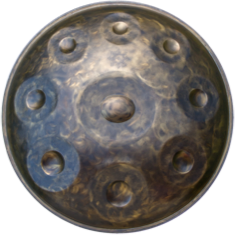About the Handpan - Shaktipan Handpan
What is a Handpan
The Handpan is an idiophone musical instrument, circular in circumference, consisting of two overlapping domes which are played by percussion with the hands, hence the name.
Around the year 2000, the first Handpan was born.
It was made by company that took inspiration from an instrument of Caribbean origin called “Steel Pan”, but which was played with the use of sticks.
In the following years, a real market was born dedicated to this hand played percussion instrument which still maintains the common name of Handpan.
There are also those who call it Pantam or Sound Sculpture precisely because it is in all respects a wonderful sound sculpture.
How a Handpan is made

The Handpan is composed of 2 domes glued one on top of the other which create a resonance chamber inside. It has a diameter that varies between 50 and 54 cm, a height of 22 cm and a weight of approximately 4.5 kg in total.
On the upper part are the notes, which represent the varieties of sound.
The notes are derived from some dimples and a flattened area called Tonefield . In the center is the Ding, the most important note and with a rounded shape. In the lower dome, however, there is the GU, a conical hole, tuned with the same scale as the upper dome.
Normally a simple instrument is made up of 8 or 9 notes in total plus the central note, but you can add more to create an instrument called a Mutant.
Each handpan is rigorously handmade and tuned to a specific scale.
How to play the pan
Being a hand percussion instrument, the handpan must be played with the hands. Normally it is placed on the legs, but there are also those who prefer the use of a stand or support, especially if played from a standing position.
A few taps of the fingers will be enough to let its harmonious sound begin to vibrate.
The music that comes from this instrument is so pleasant and engaging that it gives a feeling of profound well-being to both the musician and those who listen to it.
To play the handpan you don’t need a proper musical education. Rather it has to do with learning precisely this listening following the inspiration of the heart and the deep intuition, letting oneself be carried away by the melody that comes spontaneously.